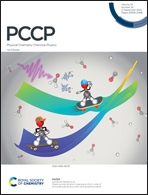Performance improvement in monolayered SnS2 double-gate field-effect transistors via point defect engineering†
Abstract
Owing to the relatively high carrier mobility and on/off current ratio, monolayered SnS2 has the advantage of suppressing drain-to-source tunneling for short channels, rendering it a promising candidate in field-effect transistor (FET) applications. To extend the scaling limit of the channel length, we propose to rationally modulate the electronic properties of monolayered SnS2 through the customized design of point defects and simulate its performance limit in sub-5 nm double-gate FETs (DGFETs), using density functional theory combined with nonequilibrium Green's function formalism. Among all types of point defects, the Se atom as a substitutional dopant (SeS) can nondegenerately inject electrons into each monolayered (ML) SnS2 2 × 4 × 1 supercell, whereas the Sn vacancy (VSn) defect exhibits an opposite doping effect. By adjusting the lateral Schottky barrier height between electrodes and the channel region, the on-state current (Ion), on/off ratio, delay time, and power-delay product in the formed n-type SeS-doped SnS2 and p-type VSn-doped SnS2 DGFETs with a channel length of 4.5 nm have been remarkably improved, fulfilling the requirements of the International Technology Roadmap for Semiconductors (ITRS) for high-performance applications in the 2028 horizon. Our work unveils the great significance of point defect engineering for applications in ultimately scaled electronics.



 Please wait while we load your content...
Please wait while we load your content...